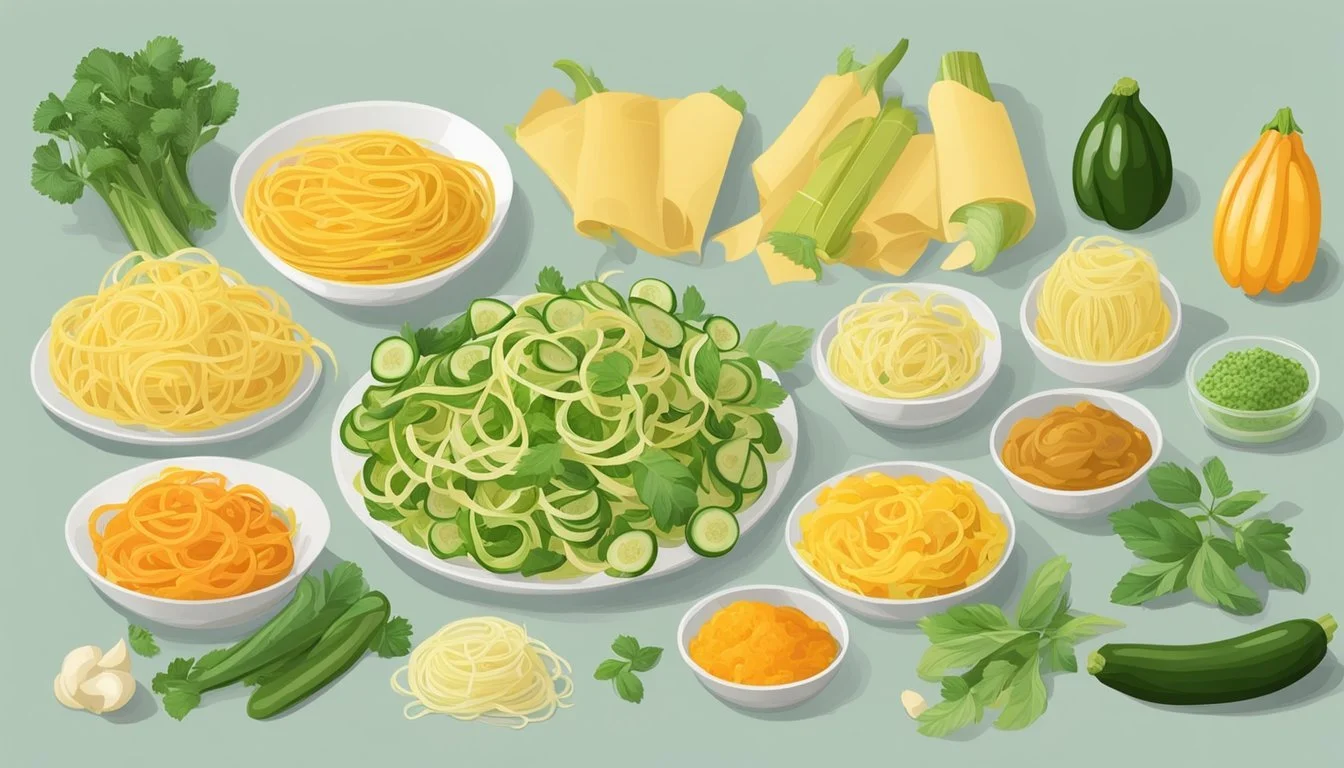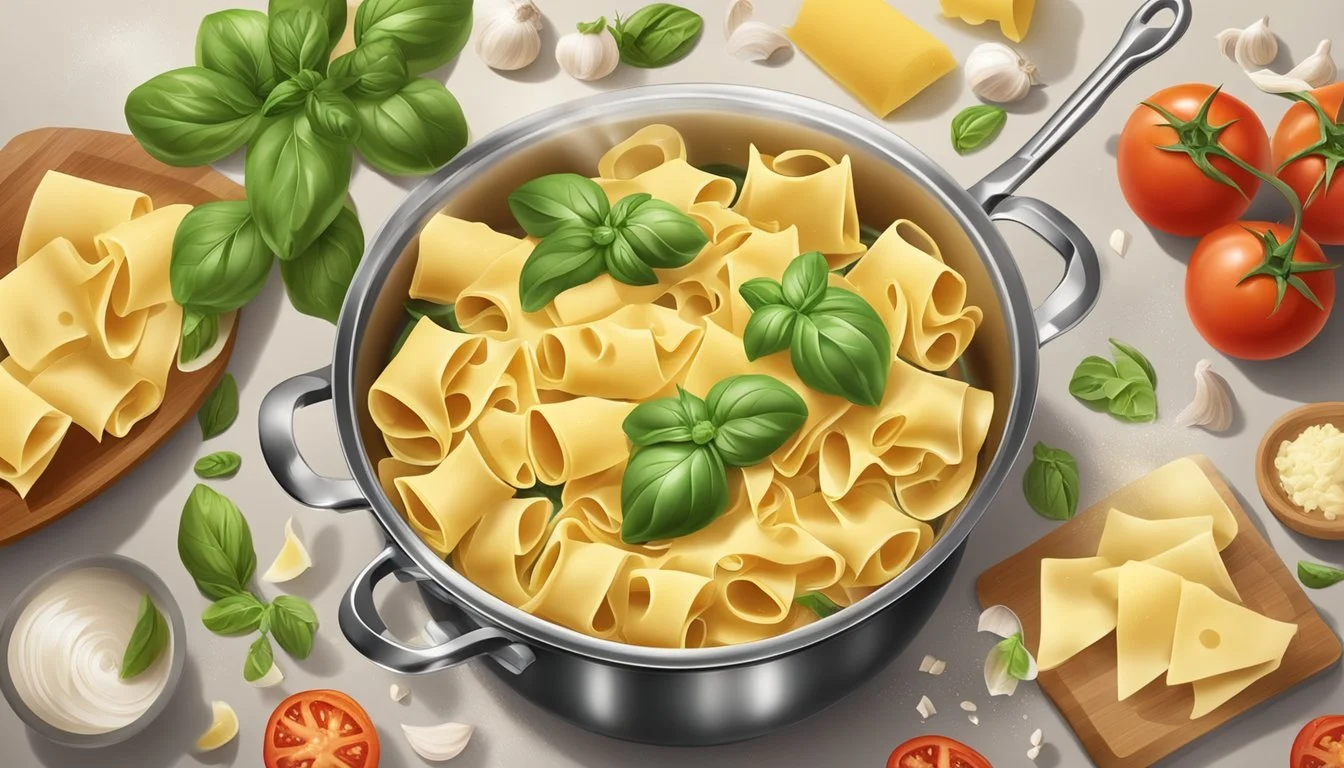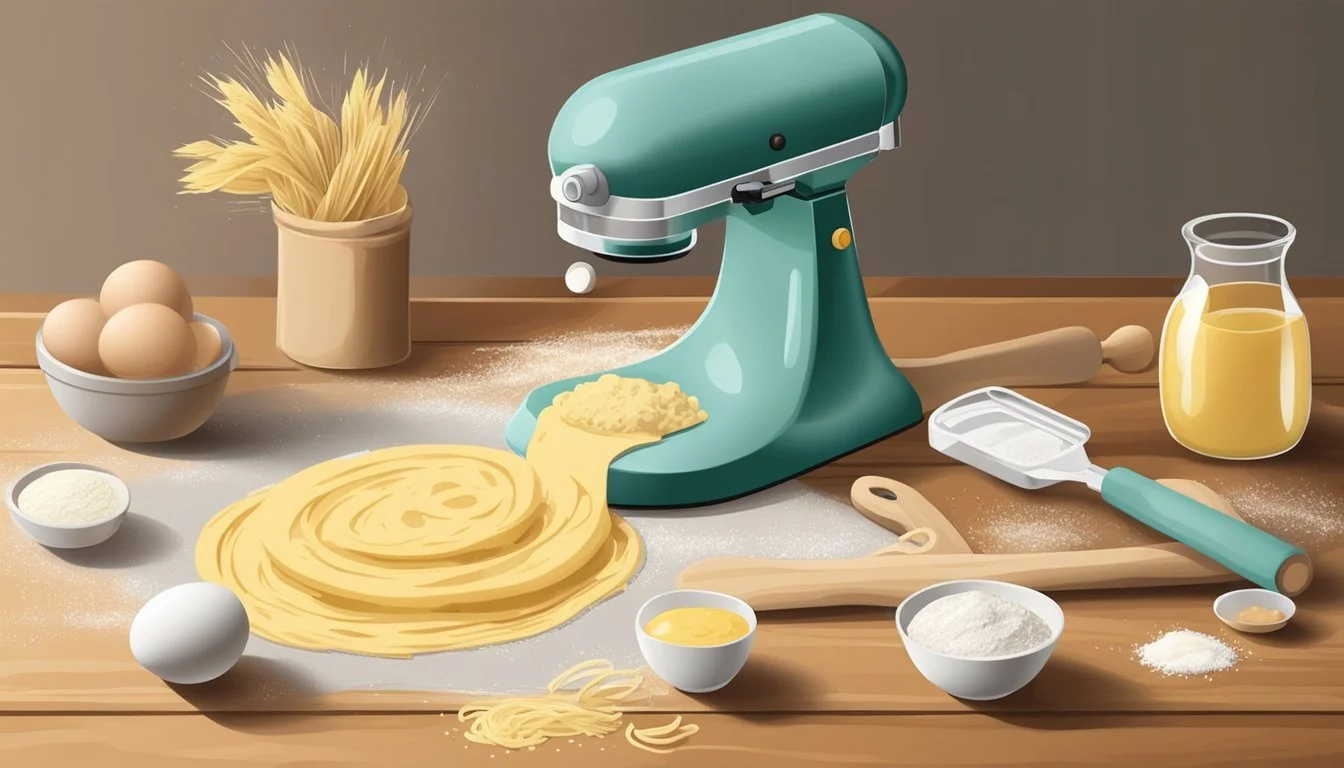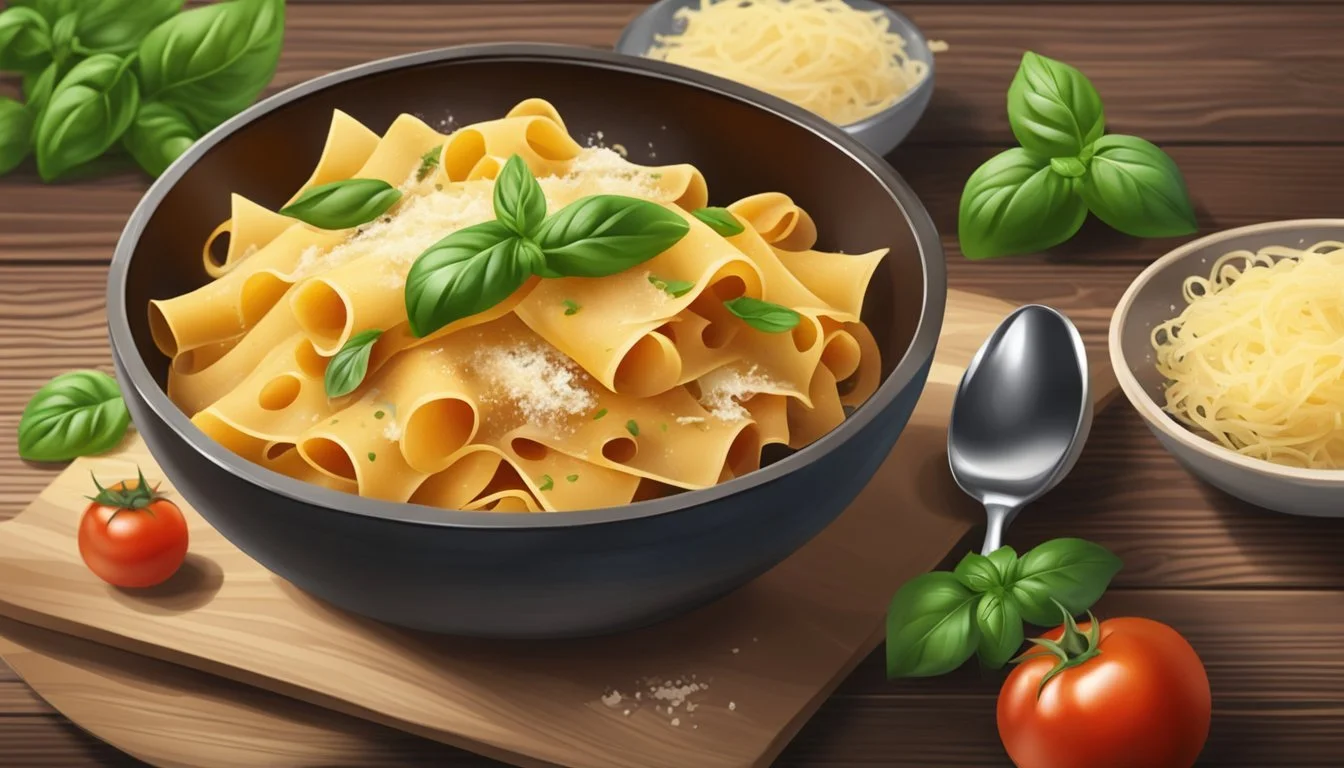Pappardelle Pasta Substitutes
Top Alternatives for Your Italian Dishes
Pappardelle pasta, with its broad and flat shape, holds a cherished place in Italian cuisine. Originating from the regions of Tuscany, Emilia-Romagna, and Marche, these wide noodles, typically made from egg pasta (What wine goes well with pasta?) dough, are ideal for holding robust sauces and are often served with meaty ragùs. Their width, which significantly surpasses that of their pasta relatives, allows for a hearty bite and a satisfying texture in every forkful.
However, despite its popularity, there are times when pappardelle may not be readily available, or home cooks might seek out alternatives for variety or dietary reasons. In such instances, a variety of substitutes are suitable replacements, each bringing a unique dimension to a dish while staying true to the heart of Italian culinary tradition.
Amongst the substitutes, tagliatelle often comes closest in texture and taste, as it similarly hails from egg-based pasta dough, though it is slightly narrower. Whether due to availability, personal preference, or creative culinary adaptations, the selection of an alternative pasta can complement the flavors of the dish intended for pappardelle, demonstrating the versatility of pasta in Italian cooking.
Understanding Pappardelle Pasta
Pappardelle pasta, a cherished Italian favorite, is renowned for its broad and flat structure, offering a robust texture that pairs exquisitely with hearty sauces. This section explores the essential characteristics and traditional uses of this distinct variety of pasta.
Characteristics of Pappardelle
Width: Pappardelle noodles are notably wide, setting them apart from other pasta types. Their standard width ranges between 2.5 to 3 centimeters (or approximately 1 inch), though the size may vary slightly by region and producer.
Texture: Typically, pappardelle has a rough and porous texture, which facilitates sauce adherence, enhancing the flavor with each bite.
Components: Made with egg pasta dough, pappardelle is rich in eggs, giving it a signature golden hue and contributes to its luxurious taste and al dente consistency when cooked.
Form: They appear as long, flat ribbons, which are sometimes slightly fluted at the edges, especially when hand-cut.
Traditional Uses of Pappardelle
Sauces: It is traditionally served with thick, robust sauces. Its broad surface and sturdy texture make it an ideal match for heavy meat sauces or ragù, particularly those featuring pork, beef, or wild game.
Regional Cuisine: In the regions of Tuscany and northern Italy, pappardelle is a staple, often highlighting the local fare and seasonal ingredients, such as mushrooms or truffles when in season.
Preparation: Whether served fresh or dried, pappardelle is best cooked to an al dente texture, ensuring a perfect bite that is neither too hard nor too soft, embodying the essence of Italian culinary tradition.
Choosing Substitute Pasta Types
When pappardelle is unavailable, certain alternatives match closely in texture and cooking properties. Substitutes not only keep dishes authentic but cater to different dietary needs or pantry limitations.
Closest Substitutes for Pappardelle
To closely mimic pappardelle's wide and flat silhouette, Tagliatelle pasta is the top choice. It is slightly narrower but delivers a comparable bite and surface area for sauces. Another near-neighbor in shape and texture is Fettuccine, which is thinner but still offers that broadness to hold onto hearty sauces.
Tagliatelle: Narrower but similar in texture.
Fettuccine: Thinner, yet a good alternative for sauce adherence.
Common Pasta Alternatives
For those in need of a quick fix who have a variety of pasta shapes on hand, several common types can substitute for pappardelle. Lasagna noodles, when sliced into ribbons after cooking, provide a similar size and chewiness. Linguine is another viable option, offering a slimmer profile but a complementary texture that can work well with substantial sauces. Rigatoni and penne pasta bring a different shape to the dish, but they too are capable of capturing thick sauces within their tubular forms.
Lasagna noodles: Cut into strips, they can replicate the size of pappardelle.
Linguine: Offers a narrower alternative.
Rigatoni/Penne: Tubular forms that catch hearty sauces well.
Gluten-Free and Specialty Substitutes
For individuals with gluten sensitivities or preferences for specialty pastas, there are several alternatives. Gluten-free alternatives are often made from a variety of flours such as rice or corn and can provide similar satisfaction to traditional pappardelle. Fusilli, available in both traditional and gluten-free forms, can be used due to its shape that traps sauces, though it differs considerably in texture from flat noodles.
Gluten-Free Tagliatelle: Made from non-wheat flours while retaining a similar shape.
Fusilli: Spiraled shape that is adept at catching sauce, widely available in gluten-free options.
Pasta and Sauce Combinations
When choosing a substitute for pappardelle pasta, one must consider the interaction between the pasta's shape and the sauce it carries. The chosen pasta should complement the texture and flavor of the sauce to maintain an authentic culinary experience.
Matching Substitutes with Sauces
Tagliatelle is most commonly recommended as a pappardelle substitute. Its similar shape and texture work well with rich meat sauces such as bolognese.
Bolognese: A robust, meat-based sauce pairs perfectly with Tagliatelle's long, flat noodles that can hold onto the chunky texture.
Carbonara: The creamy texture of Carbonara sauce is well supported by the sturdy nature of Tagliatelle or Mafaldine noodles, ensuring a balanced bite.
Mafaldine, with its ruffled edges, is exceptional at trapping and holding onto chunky or cream-based sauces.
Pesto: Its decorative grooves are ideal for pesto's herbal and nutty elements to cling to, delivering an evenly distributed flavor.
Sauce Consistency and Pasta Choice
The consistency of a sauce influences the selection of pasta. When dealing with cream sauces or tomato-based sauces, consider how well the pasta will support and interact with the sauce.
Tomato-Based Sauces: Slightly wider noodles like Mafaldine can carry these sauces effectively, their surfaces providing ample area for the sauce to adhere to.
Cream Sauces: A smoother pasta such as Tagliatelle is preferable. The surface area of the pasta should be enough to allow the creamy sauce to coat each strand evenly.
In summary, selecting the right pasta for your sauce is fundamental to creating a harmonious dish. Whether the sauce is hearty and meaty or light and creamy, choosing a pasta with the right shape and texture is key to a satisfying culinary experience.
Cooking Instructions for Substitutes
When substituting for Pappardelle noodles, it's imperative to adjust cooking times and techniques due to the variations in noodle width and texture. Close attention to these details will ensure the pasta comes out al dente, with that perfect bite.
Adjusting Cook Time and Technique
Tagliatelle: Slightly narrower than Pappardelle, they should be cooked in boiling, salted water for about 6-9 minutes.
Mafaldine: These come with ruffled edges and may require 8-10 minutes in boiling, salted water.
Lasagna noodles: If cut to size, they should be boiled for 10-12 minutes.
It is essential to start checking the pasta a few minutes before the lower end of the recommended cooking range. For every substitute, stirring occasionally prevents sticking.
Tips for Perfect Al Dente Pasta
Dough Consistency: For pasta substitutes with egg-based dough, ensure it's rolled out uniformly for even cooking.
Salted Water: Use approximately 1 tablespoon of salt for every 4 quarts of water to enhance the pasta's flavor.
Testing for Doneness: Begin tasting for al dente texture a few minutes before the expected cook time ends. Pasta should be firm to the bite.
Remember that stovetop heat can vary, and these timings serve as a guide that should be adjusted based on actual conditions. Always reserve some pasta water for sauce adjustment if necessary.
Recipes and Dish Pairings
When substituting pappardelle pasta in recipes, it's essential to consider how well the alternative pasta will pair with the flavors and textures of the dish, ensuring that the integrity of the traditional Italian dishes or innovative pasta creations is maintained.
Substitutes in Traditional Italian Dishes
Italian cuisine often pairs pappardelle pasta with rich, hearty sauces due to its wide, flat surface that holds sauces well. In classic Bolognese sauce, a staple in Italian cuisine, tagliatelle serves as an excellent substitute for pappardelle. The similar width and texture allow the meat-based sauce to cling to the noodles, providing a comparable mouthfeel and flavor absorption.
Substitute: Tagliatelle
Traditional Dish: Bolognese Sauce
In creamy dishes like Fettuccine Alfredo, which traditionally uses fettuccine, the pasta can be substituted without compromising the dish's integrity. The creamy sauce binds well with the flat noodles, ensuring every bite is as satisfying as with pappardelle.
Substitute: Fettuccine
Dish: Fettuccine Alfredo
For baked dishes like lasagna, which require wide pasta layers, lasagne noodles can replace pappardelle sheets. The noodles should be cooked, sliced into broad strips, layered with cheese, sauce, and other ingredients, and then baked to achieve a similar texture.
Substitute: Lasagne Noodles (cut into strips)
Baked Dish: Lasagna-style Casseroles
Innovative Pasta Dish Ideas
Experimentation in the kitchen can lead to delightful new dishes. For a twist on beef stroganoff, try using lasagne noodles cut into strips after cooking. Their width can handle the hearty beef and mushroom gravy, making for a satisfying alternative to traditional egg noodles.
Bold undertakings can include using ribbon-like cut lasagne noodles in seafood dishes, offering a textural contrast to the delicate seafood. The broad noodles can scoop up heavier seafood stews or soups with ease, allowing for a balance in every bite.
Substitute: Lasagne Noodles (ribbon-like cut)
Dish: Seafood Stews and Soups
By carefully selecting substitutes, cooks can preserve the character of Italian classics and innovate new pasta dishes with confidence.
Preparing Homemade Pasta Substitutes
When pappardelle is not available, one can prepare suitable substitutes at home to match the pasta's wide, flat shape and texture.
Creating Fresh Alternatives at Home
Making fresh pasta at home allows for flexibility in shaping and sizing to closely mimic pappardelle. For instance, tagliatelle is a narrower pasta but shares a similar egg pasta dough composition. To begin:
Roll the dough: Roll out the pasta dough to the desired thickness, typically about 1mm.
Cut the pasta: Use a knife or pasta cutter to slice the dough into long, wide ribbons. If aiming for tagliatelle, cut the ribbons to about 6.5 to 10 millimeters in width.
Cook until al dente: Fresh pasta cooks quickly, so monitor closely to prevent overcooking.
This manual cutting allows one to determine the width and ensures they achieve the desired substitute to closely match pappardelle.
Homemade Alternative Ingredients
The staple ingredients for homemade pasta dough, which can be used for pappardelle substitutes, include:
Flour: All-purpose flour works well, but "00" flour is ideal for a more authentic texture.
Eggs: Fresh eggs are essential for richness and color.
Salt: A pinch of salt for flavor.
Water: As needed, to achieve a pliable dough consistency.
Ingredient Quantity Flour 2 cups Eggs 3 large Salt 1/2 tsp Water If needed
The key is to create a dough that is not too sticky, yet not too dry, and can be easily rolled out and shaped. Homemade pasta gives one the control to replicate the substantial bite and porous texture that is ideal for holding onto hearty sauces, just like pappardelle.
Nutritional Considerations
When exploring the range of pasta substitutes for Pappardelle, it's important to consider not only taste and texture but also the nutritional aspects. Pasta alternatives may offer distinct health benefits and vary in caloric and fiber content, which are significant factors for those managing their dietary intake.
Health Benefits of Alternative Pastas
Whole Wheat Pasta: This substitute contains more nutrients compared to traditional pastas. It is particularly rich in B vitamins and minerals such as iron, calcium, and magnesium. Whole wheat pasta also typically has a higher protein content, making it a nutritionally dense option.
Spinach Pasta: Often chosen for its high vitamin A and vitamin C content, spinach pasta brings a wealth of antioxidants and may contribute to a healthier immune system. Its ingredients often include spinach in addition to traditional pasta ingredients, offering a vegetable boost in every bite.
Zucchini Noodles: Notably low in calories and carbohydrates, zucchini noodles are an excellent choice for those looking for a lighter alternative. They provide significant levels of potassium and vitamin C, and they are an easy way to increase one's vegetable intake.
Caloric and Fiber Content in Pasta Substitutes
Pasta Substitute Calories (per 100g) Fiber (per 100g) Whole Wheat Pasta ~ 124 ~ 6.3g Spinach Pasta ~ 131 ~ 2.5g Zucchini Noodles ~ 17 ~ 1g
Pasta substitutes like whole wheat pasta tend to have a higher fiber content, which can aid in digestion and provide a longer feeling of fullness. Fiber is a key nutrient that supports healthy digestion and can contribute to maintaining a healthy weight.
In contrast, substitutes such as zucchini noodles, while lower in fiber, are much lower in calories. This makes them an attractive option for individuals who are calorie-conscious. The caloric difference between traditional pastas and some vegetable-based alternatives is significant, rendering them suitable for low-calorie diet plans.
Shopping and Storage Tips
When searching for pasta alternatives, one may consider a variety of options available in grocery stores, and each substitute may have different storage requirements to maintain freshness.
Finding Substitutes in Grocery Stores
In grocery stores, shoppers can find a selection of pasta made from durum wheat or semolina flour, which ensures a firm texture upon cooking. For Pappardelle substitutes, they should look for Tagliatelle, which is comparable but slightly narrower. Fettuccine is another good option, recognizable by its long, flat ribbons.
Durum wheat pasta: It's known for its high protein content and firm texture.
Semolina flour pasta: Offers a rougher surface that's ideal for clinging to sauces.
All-purpose flour pasta: A possible base for softer noodles if other options are not available.
Proper Storage for Pasta Longevity
Pasta longevity depends on proper storage. Dried pasta should be stored in a cool, dry place such as a pantry. To maintain quality, one should seal pasta in an airtight container after opening the original packaging.
Dried pasta: Store in airtight containers away from moisture and light.
Fresh pasta: Keep refrigerated and consume by the recommended date.
By adhering to these simple storage tips, pasta can retain its desirable texture and taste until its next use.
Conclusion
When crafting Italian dishes requiring pappardelle pasta, the diversity of substitutes allows one to adapt based on availability and personal preference. Tagliatelle, with its similar width and texture, serves as the most popular alternative, enabling the seamless replication of traditional recipes. Slightly narrower, fettuccine is also an excellent choice, providing a similar mouthfeel and an ability to hold sauces well.
For visual appeal and unique sauce-catching abilities, one might consider mafeldine, characterized by its decorative edges. In the event of missing pappardelle, even lasagna noodles, cut into strips, can step in as a resourceful stand-in, although they offer a different bite.
Here's a brief overview of substitutes:
Tagliatelle: Closest in width and feel
Fettuccine: A thinner, yet suitable option
Mafaldine: Adds texture and visual flair
Lasagna noodles: An unconventional but workable choice
When using these substitutes, one should remember to adjust cooking times accordingly to achieve the 'al dente' texture so cherished in Italian cuisine. Each pasta type offers its unique charm to dishes, embracing the flexibility inherent in Italian cooking. Chefs and home cooks alike may select alternatives based on what lies in their pantry, ensuring the essence of the dish is honored even with these variations.








